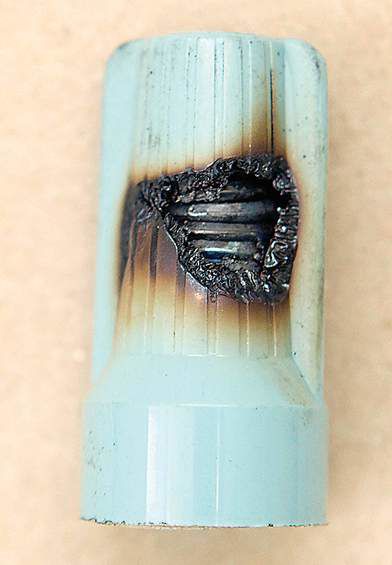Drywall disaster
Published 5:00 am Thursday, October 8, 2009

- ABOVE: Retired Virginia policeman Bill Morgan draws the blinds in his empty dream home in Williamsburg, Va. Morgan had to abandon the house after his family developed medical problems involving constant headaches and nosebleeds.
When Bill Morgan, a retired Virginia policeman, moved into his newly built dream home three years ago, his hopes were quickly dashed.
His wife and daughter suffered constant nosebleeds and headaches. A persistent foul odor filled the house. Every piece of metal indoors corroded or turned black.
In short order, Morgan moved out. The headaches and nosebleeds stopped, but the ensuing financial problems pushed him into personal bankruptcy.
“My house is not worth the land it’s build on,” said Morgan, who could not maintain the mortgage payments on his $383,000 home in a Williamsburg, Va., subdivision called Wellington Estates, and the costs of a rental property where his family decamped.
Morgan, like many other American homebuyers who tell similar tales of woe, is blaming the drywall in their new homes — specifically, drywall from China, imported during the housing boom to meet heavy demand — that they say is contaminated with various sulfur compounds.
Hundreds of lawsuits are piling up in state and federal courts, and a consolidated class action is moving forward in Louisiana before Judge Eldon Fallon of U.S. District Court, who will begin hearing cases in January.
Three hundred cases have been filed in Louisiana alone, many with similar complaints from homeowners — a noxious smell, recurrent headaches and difficulty breathing. In Florida, the health department has received more than 500 complaints with such symptoms.
In addition, these suits say, metal objects in homes corrode quickly, causing kitchen appliances, air conditioners, televisions and plumbing to fail.
“There could be 60,000 to 100,000 homes that are worthless and have to be ripped completely down and rebuilt,” said Arnold Levin, a Philadelphia lawyer and co-chairman of the plaintiffs’ steering committee.
While tainted Chinese imports like toothpaste, pet food and baby formula have been quickly removed from store shelves, drywall is installed throughout homes and does not lend itself to a quick fix.
This month, the Consumer Product Safety Commission, whose investigation into Chinese drywall is the largest in its history, will release the results of a study to determine why the drywall is causing problems, and what kind of remediation programs might be effective.
Already, the commission has sent six investigators to Chinese gypsum mines and to meet with the government there. The Chinese government’s counterpart to the federal safety commission sent two of its experts here to inspect affected homes.
The commission is also making sure that no more Chinese drywall comes into the country.
“Our ports are on alert,” said Inez Tenenbaum, chairwoman of the commission. “They are not letting any in. The market, too, has corrected. No one wants Chinese drywall.”
Even President Barack Obama is being pressed by members of Congress to raise the issue on his November trip to China — the loudest cry coming from Sen. Bill Nelson, D-Fla., who has traveled to China on his own to learn more about the drywall problems.
Investigators are finding that getting scientific data, establishing legal accountability and following a supply chain is difficult when so many drywall sheets — millions in all were brought into the United States — were simply marked “Made in China,” providing no clues to their actual source. The drywall was brought in because U.S. supplies ran low, not as a cost-saving measure for builders.
One puzzle is why problems have surfaced in the United States and not Asia, where drywall was also sold. According to a safety commission official who declined to be named because of the delicacy of the issue, a theory offered by Chinese officials during their visit to the United States was that American homes are more tightly built, with less ventilation than homes in China.
One drywall manufacturer, Tishan Gypsum Co. Ltd., which is controlled by the Chinese government, was found to be in preliminary default last week by a federal judge after the company failed to show up in court.
But whether the Florida builders who brought the class-action lawsuit could ever collect on any future judgment remains unclear, because of the difficulty of gaining jurisdiction and enforcing rulings against foreign companies, especially in China. In other cases, many of the Chinese companies cannot be found or have disbanded.
The product safety commission has received more than 1,300 complaints from 26 states, but the bulk are from Florida, Louisiana and Virginia, where hurricanes led to an unprecedented housing boom in 2006 and 2007.
There are estimates that it costs $100,000 to $150,000 per home to rip out and replace tainted drywall and the electrical equipment attached to it. In these cases, homes are being stripped down to the studs and new drywall is installed.
Some home builders, worried about their reputations, are doing just that. Lennar Corp. has set aside $40 million for home repairs, while it tries to collect from its insurance company and sues several Chinese suppliers and American middlemen. Lennar declined to comment.
But many smaller home builders, hoping to survive the downturn, do not have such deep pockets.
For that reason, some members of Congress hope the federal government will provide financial assistance for their constituents, just as it does after natural disasters.
There may be local relief, too. Broward County, Fla., has cut property assessments by as much as 20 percent in some affected areas and Miami-Dade is considering a similar tax break. “Florida is hypersensitive to hurricanes and this is like a silent hurricane,” said Rep. Robert Wexler, D-Fla. “Whole neighborhoods are being wiped out in terms of property values and people’s ability to remain in their homes.”






